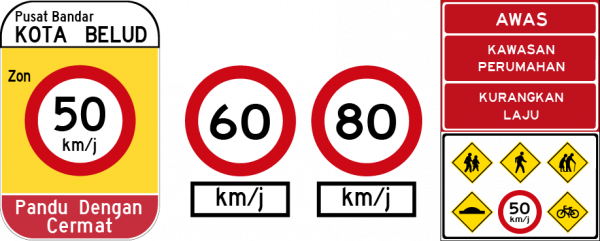No edit summary |
(Adding SL signs) |
||
| Line 6: | Line 6: | ||
<big>'''Statutory Speed Limit'''</big><br /> | <big>'''Statutory Speed Limit'''</big><br /> | ||
Statutory speed limits, also known as the National Speed Limits ''(Had Laju Kebangsaan)'', are based on the concept that uniform categories of highways can operate at certain maximum speed under ideal conditions. The National Speed Limits applicable for expressways, federal roads, state roads and municipal roads. | Statutory speed limits, also known as the National Speed Limits ''(Had Laju Kebangsaan)'', are based on the concept that uniform categories of highways can operate at certain maximum speed under ideal conditions. The National Speed Limits applicable for expressways, federal roads, state roads and municipal roads. | ||
[[File:Statutory SL.png|600px]]<br /> | |||
<big>'''Local/Zonal Speed Limit'''</big><br /> | <big>'''Local/Zonal Speed Limit'''</big><br /> | ||
These alternative speed limits are usually lower than those prescribed by the National Speed Limit. Legislated through the process of gazette, these speed limits are established on basis of engineering study, and becoming effective when the limits are posted and properly recorded. | These alternative speed limits are usually lower than those prescribed by the National Speed Limit. Legislated through the process of gazette, these speed limits are established on basis of engineering study, and becoming effective when the limits are posted and properly recorded. | ||
[[File:Local SL.png|600px]]<br /> | |||
<big>'''Advisory Speed Limit'''</big><br /> | <big>'''Advisory Speed Limit'''</big><br /> | ||
Advisory Speed Limit is usually recommended by the road authority, but is not strictly enforced. These speed limits are often set in areas with many pedestrian activities (school zones) and on difficult stretches of roads such as on speed bumps, tight corners or through roadwork zones. | Advisory Speed Limit is usually recommended by the road authority, but is not strictly enforced. These speed limits are often set in areas with many pedestrian activities (school zones) and on difficult stretches of roads such as on speed bumps, tight corners or through roadwork zones. | ||
[[File:Advisory SL.png|600px]] | |||
Revision as of 05:39, 28 November 2017
Speed Limit (SL) is a regulatory traffic control means enacted under Section 69 of the Road Transport Act 1989 (Act 333) which is necessary to control the speed of vehicles for safety reasons. It is implemented by the road authorities to inform the motorists of the appropriate driving speeds and these limits are enforced by the police or road transport authorities.
Types of Speed Limits 
Statutory Speed Limit
Statutory speed limits, also known as the National Speed Limits (Had Laju Kebangsaan), are based on the concept that uniform categories of highways can operate at certain maximum speed under ideal conditions. The National Speed Limits applicable for expressways, federal roads, state roads and municipal roads.
Local/Zonal Speed Limit
These alternative speed limits are usually lower than those prescribed by the National Speed Limit. Legislated through the process of gazette, these speed limits are established on basis of engineering study, and becoming effective when the limits are posted and properly recorded.
Advisory Speed Limit
Advisory Speed Limit is usually recommended by the road authority, but is not strictly enforced. These speed limits are often set in areas with many pedestrian activities (school zones) and on difficult stretches of roads such as on speed bumps, tight corners or through roadwork zones.


